It may not be coincidence that the arrival of a new Hi-Mart in the area coincided with Korean Mother's decision to replace her old TV with its washed out picture created by technologically uncertain means, which is why I took to hanging around at electrical stores recently taking pictures of dancing girls while there.
This being Korea, it's probably no surprise to find that if you're in the market for a new TV, you're probably buying a Samsung or an LG. But in the first of many oddities which is the Korean TV shopping experience, don't expect them to be branded as such. Samsung's TV brand is 'PAVV' and LG's is 'Xcanvas'. When I first got to Korea I wondered whether these might be cheap Chinese imports - and couldn't understand why the Koreans weren't buying local - I really should have known better even back then.
Another mistaken notion of Korea I had back in those days was that it would prove to be a land of milk and honey as far as technology was concerned. I've long since resigned myself to having, what is these days, a slower Internet connection than I had back in the UK, and now the TVs provide another disappointment. It's unscientific but comparing prices in Hi-Mart with prices from a similar type of store in the UK, called Comet, has tended to suggest that Korean prices are 10-20% higher than for equivalent models back home. This is even more surprising considering the UK's VAT sales tax is 17.5% compared with Korea's 10%, and UK TVs tend to have teletext and digital terrestrial tuners built in which Korean TVs don't. The TV in the picture above - a PAVV 52" LCD - has a price of 5,000,000 won, about £2,649, whereas a 52" Samsung is currently £2,300 from Comet. It may be the case that Korean retailers are more open to haggling than British ones, although the latter aren't necessarily adverse to it either, but as things stand you'd have to be talking them down by quite a margin just to get to British prices. It's really not what I would have expected at all. On the other hand, the iPod Touch is cheaper here, but then that's American. Why do Koreans have to pay more for Korean products?
In addition to Hi-Mart, we also browsed round LG and Samsung stores, where of course, they only sell their own products, and if anything, at even higher prices. I am told there is a school of thought here that the PAVVs or Xcanvas TVs in Hi-Mart are not perceived to be the same quality as the same models sold by Samsung and LG stores respectively, and I suspect there's a marketing department somewhere not so far away from here patting themselves on the back for getting that rumour started.
Salespeople back home do not have good reputations, but compared to some of the sales staff we met in our travels they are evidently experts in their field. Knowing little of the world of flat-panel TVs we'd done a little research beforehand and arrived in the Korean stores asking what seemed fairly basic questions about contrast ratios and scan types, to the blank looks and occasional alarm of staff who had, moments earlier, enthusiastically approached us. Eventually we usually found someone we could talk to, but in one store a resident 'technical guy' insisted that the black glossy LCD panels don't really suffer from reflections these days - while we were standing next to such a panel happily displaying its HD image along with a pretty good mirror image of the stores lights. I was amazed by his sheer audacity.
I've written before about ajummas andajeoshis, which are more than merely terms, they are almost definitions of a type of behaviour. Within the ajumma section of society there is something even more eye-opening - the phenomena of the rich ajumma - or at least, the reasonably well off one. Korea isn't quite Japan, but while the economy's rapid rise in the last few decades hasn't been to the benefit of all, there is retired class of people, especially women, who have a lot of leisure time and money to go along with it. So the stereotypical story goes something like this - ajumma walks into a TV store, parks herself in front of the screen which most takes her fancy, possibly haggles a little for old times' sake, and then buys it. She likes the picture and the design of the TV and hasn't the first idea about any of the specifications, which of course, suits the salesperson perfectly because that means they don't have to either.
So the staff of various stores found they had to talk details to us, and we were ploughed with drinks, strange green rice sweets and foot massagers while they consulted sales leaflets or disappeared off to find someone who knew the answers to our questions.
Eventually we failed to persuade Korean Mother to buy an Xcanvas with a PVR, as she instead opted for a similarly-priced PAVV without one, on the grounds that she didn't like the Xcanvas bezel design, though she did end up getting a free vacuum cleaner and digital camera - Samsung of course - with the deal. And in a final reflection that some things don't change in Korea, she found someone in the extended social network who worked in another Hi-Mart somewhere else in Busan to do a better deal that we'd found locally.
I'm sure it says something about Korea's service culture that it's not uncommon to see trucks with pictures of their drivers displayed on the back, somehow serving to put a human face on an otherwise faceless corporation. It says something else that it's taken as read that the people who deliver your new TV will install it even if that requires a wall mounting. If there are any problems, we should give him a call - and specifically him rather than the company generally, because now in some small way it's his responsibility and he's our TV support person.
As for the TV itself, there's still nothing on worth watching, but we did find a USB port on the side which now enables us to show Korean Mother our photos in an alarming amount of detail in the comfort of her own home. And Korean Mother's happy because now she watches her period dramas in high definition on KBS, although for me the ability to suddenly see the actors' dental work and contact lenses somewhat destroys the historical image for me.
Korean tags: 가게, 사다

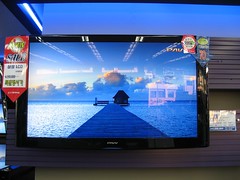
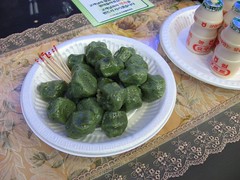
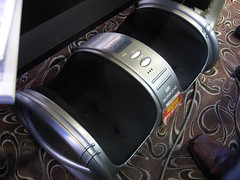


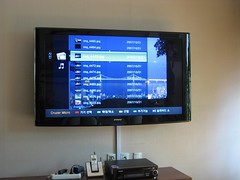
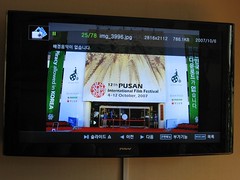
No comments:
Post a Comment